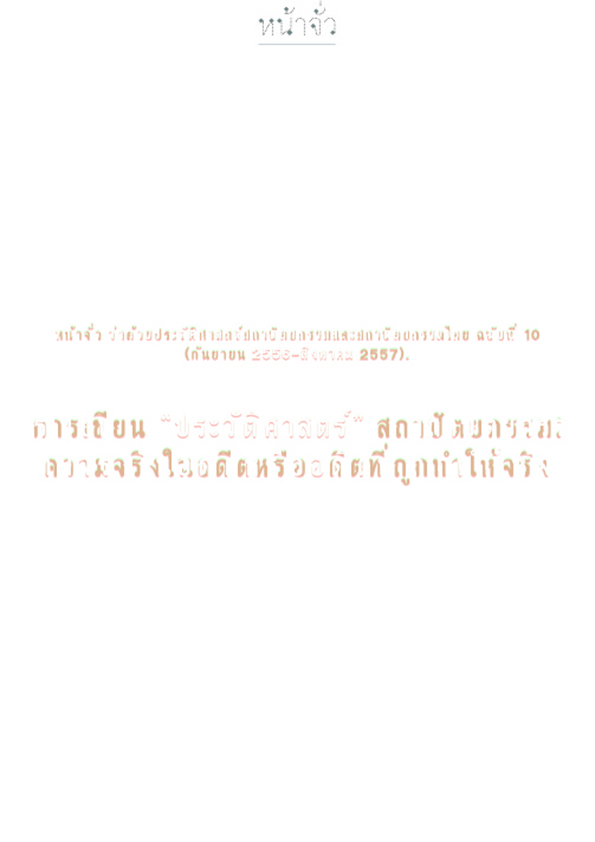ไทย-ลานนา ล้านนา-ไทย : ประวัติศาสตร์นิพนธ์ สถาปัตยกรรมล้านนา (พุทธศตวรรษที่ 25–พ.ศ. 2549) Thai-Lanna : The Historiography of Lanna Architecture (20th century–2006)
Main Article Content
Abstract
บทคัดย่อ
บทความนี้มุ่งเน้นอธิบายประวัติศาสตร์นิพนธ์ของ “สถาปัตยกรรมล้านนา” อันเป็นรูปแบบหนึ่งของสถาปัตยกรรมที่มีลักษณะเฉพาะและถือว่ามีพลวัตในตัวเองสูง งานเขียนนี้ตั้งอยู่บนแนวคิดที่ว่า ประวัติศาสตร์นิพนธ์ย่อมเชื่อมโยงอยู่กับโลกทัศน์และความรู้สึกนึกคิดของผู้ประพันธ์ซึ่งไม่อาจแยกได้จากโครงสร้างทางการเมือง เศรษฐกิจ และสังคมที่มีการแปรเปลี่ยนไปตลอดเวลา ในที่นี้จึงใช้การอธิบายด้วยแนวพินิจทางประวัติศาสตร์ (Historical approach) เพื่อทำความเข้าใจการสร้างองค์ความรู้เกี่ยวกับประวัติศาสตร์สถาปัตยกรรมล้านนา ที่คลี่คลายไปตามยุคสมัยในข้อเขียนประวัติศาสตร์ รวมถึงบริบทที่งานเขียนนั้นปรากฏอยู่ ประโยชน์ของการศึกษาแนวพินิจทางประวัติศาสตร์ก็คือ ทำให้เข้าใจความเปลี่ยนแปลงประวัติศาสตร์นิพนธ์ที่เชื่อมโยงกับลักษณะเฉพาะของยุคสมัย ขณะที่ข้อจำกัดของแนวการศึกษาเช่นนี้ก็คือ การเข้าถึงหลักฐานชั้นต้นที่หากว่าไม่สามารถมีข้อมูลมากพอ อาจทำให้ไม่สามารถอธิบายผ่านบริบทที่ซับซ้อนได้
ขอบเขตของการศึกษาด้านพื้นที่ครอบคลุมสถาปัตยกรรมล้านนาใน 8 จังหวัดภาคเหนือ ได้แก่ เชียงใหม่ ลำปาง ลำพูน เชียงราย พะเยา แพร่ น่าน และแม่ฮ่องสอน ขณะที่ห้วงเวลาที่ทำการศึกษานั้น นับเริ่มตั้งแต่การศึกษาประวัติศาสตร์แบบตะวันตก ต้นพุทธศตวรรษที่ 25 จนมาถึง พ.ศ. 2549 ที่ถือเป็นการเปลี่ยนแปลงการเมืองร่วมสมัยครั้งใหญ่ นั่นคือ การรัฐประหาร ปลายปีเดียวกันยังมีการจัดงานมหกรรมพืชสวนโลกเฉลิม พระเกียรติฯ ราชพฤกษ์ที่เชียงใหม่ ที่มีแกนกลางของงานอยู่ที่หอคำหลวง อันเป็นสถาปัตยกรรมล้านนาที่มีความโดดเด่นเป็นอย่างยิ่ง ภายใต้โครงสร้างการเมืองที่รวมศูนย์อำนาจเข้าสู่ศูนย์กลางเป็นระยะเวลาเกือบ 100 ปี ท้องถิ่นในดินแดนที่เรียกว่าล้านนา เริ่มสร้างพลังการต่อรองทางการเมืองและเศรษฐกิจมากบ้างน้อยบ้าง แต่ก็มีข้อจำกัดด้วยนโยบายการรวมศูนย์ของรัฐและงบประมาณที่จำกัด อย่างไรก็ตาม เราอาจพบว่าปัญหาการรวมศูนย์อำนาจทางวัฒนธรรมมิได้อยู่ที่กรุงเทพฯ เท่านั้น อาการดังกล่าวยังเกิดกับเชียงใหม่ที่มีความเหนือกว่าจังหวัดอื่น ๆ ไม่ว่าจะเป็นงบประมาณสนับสนุนจากส่วนกลาง การมีสถาบันการศึกษาระดับอุดมศึกษา หรือกระทั่งการลงทุนที่ขยายตัวมากับการท่องเที่ยวและงานภาคบริการ ทำให้โครงการและการศึกษาสถาปัตยกรรมล้านนาจึงมีอำนาจเหนือกว่าพื้นที่อื่น ๆ
หลักฐานที่ใช้อ้างอิงมาจากเอกสารประเภทบทความและหนังสือ ที่สร้างชุดองค์ความรู้เกี่ยวกับสถาปัตยกรรมล้านนา ที่เริ่มอย่างเป็นชิ้นเป็นอันโดยสมเด็จฯ กรมพระยาดำรงราชานุภาพ ใน ตำนานพุทธเจดีย์ (2469) และหนังสือเอกสารต่าง ๆ อีกจำนวนมากที่เป็นงานนิพนธ์ที่เกี่ยวข้อง ไม่ว่าจะเป็นผลงานนักวิชาการท้องถิ่นหรือจากต่างถิ่น ไม่เพียงเท่านั้น เอกสารสรุปและเอกสารประกอบการสัมมนาเกี่ยวกับองค์ความรู้สถาปัตยกรรมล้านนาที่เกิดขึ้นตั้งแต่ทศวรรษ 2520 รวมถึงหนังสืออนุสรณ์งานศพ และอนุสรณ์ที่ระลึกในวาระต่าง ๆ ที่ได้จัดวางและผลิตซ้ำองค์ความรู้เกี่ยวกับสถาปัตยกรรมล้านนาสู่สาธารณชนก็จะทำให้เราเห็นบริบทที่เคลื่อนไหว ส่วนสุดท้ายก็คือ องค์ความรู้ที่เกิดจากการค้นคว้าวิจัยในสถาบันการศึกษา นั่นคือ วิทยานิพนธ์ระดับปริญญาโทของนักศึกษาคณะสถาปัตยกรรมศาสตร์ มหาวิทยาลัยศิลปากร ที่เริ่มอย่างช้าใน พ.ศ. 2535 และรายงานวิชาการศึกษาเฉพาะเรื่อง นักศึกษาระดับปริญญาตรี สาขาศิลปะไทย คณะวิจิตรศิลป์ มหาวิทยาลัยเชียงใหม่ ตั้งแต่ทศวรรษ 2530 เป็นอย่างช้า ที่จะกลายเป็นฐานความรู้สำคัญเกี่ยวกับศิลปสถาปัตยกรรมล้านนาอีกแหล่งหนึ่ง
Abstract
This article focuses on the historiography of Lanna architecture, the form of specific architecture that has its own dynamic change. This paper bases on the concept that the historiography should relate with the world view and the mentality of the author that cannot be separated from the structure of politics, economics and society. Historical approach is used at the methodology of this analysis to understand the construction of knowledge about Lanna architecture that has changed along the time. The evidences are the historical documents and the contexts surrounding the documents. The benefit of historical approach is the way to understand the historiography that link to the specific phenomenon of the time. The limitation is the access to the primary source. The less information it gets, the less complex explanation it is.
The area of this study covers on 8 provinces in Northern Region such as Chiangmai, Lampang, Lamphun, Chiangrai, Phayao, Phrae, Nan and Maehongson, while the period is around 20th century when the starting of Western discipline of historiography to 2009, the time of great change of Thai contemporary politics-Coup d'etat. In the same year Chiangmai is the location of the "Royal Flora Ratchapruek 2006" and the center of the fair is the location of “Hor khum Luang” (royal palace) that is very magnificant architecture there. The structure of centralization of the Central Government for 100 years, the localities called Lanna have seek to empower themselves in many ways but the great obstacles are the centralization policy and the limited budget. However not only Bangkok has been centralized but Chiangmai another big city in the north which has got the great advantage from more budget for construction of the universities, colleges with their resources. Moreover; the investment of the private sector for tourism and services that make the projects and the studies of Lanna architecture dominated all the northern region.
The evidences for reference come from documents like the articles, books that has constructed knowledge about Lanna architecture. The first document is “Tam Nan Bhudda-Jedi” (Buddhist stupa legend, 1926) by Prince Damrong and many of the books from local and national scholars. Moreover; there are the documents from the seminar since 1980s and the commemorative books that contain and reproduce the articles about Lanna arts and architecture to the public continuously. Finally, the knowledge from the researches from the academic institutes such, the thesis of the master degree in history of architecture, faculty of Architecture, Silpakorn university in 1992 and the individual study the students from Thai art major, Faculty of fine arts, Chiangmai university at least in 1990s that would be the another knowledge of Lanna arts and architecture.


